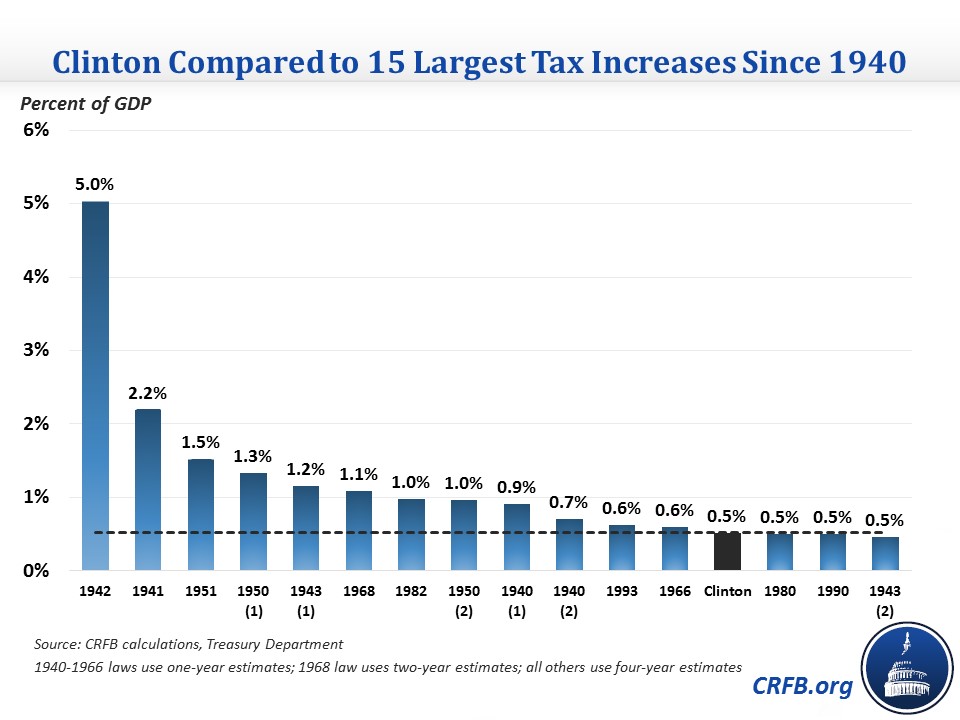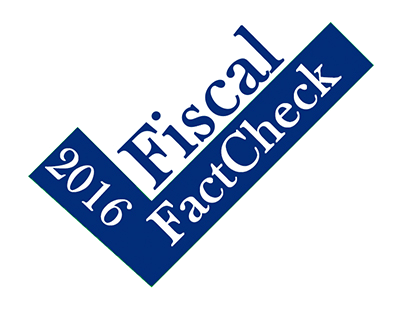Is Clinton's Tax Increase One of the Largest in History?
In addition to a statement about his tax cut during the first presidential debate in late September, Republican presidential nominee Donald Trump said to Democratic nominee Hillary Clinton, "You are going to approve one of the biggest tax increases in history." Whether this statement is true depends on the measure you use. In inflation-adjusted dollars, Clinton's proposed tax increase is the second largest since 1940, while as a percentage of Gross Domestic Product (GDP), her proposed tax increases would not be among the top 10 over the same time frame. Due to the mixed results, we rule that this statement is complicated.
As with Trump's tax cut claim, we use a 2013 report by Jerry Tempalski of the Treasury Department that compiles every estimate made since 1940 at the time major tax bills have passed. One-year estimates are available for laws passed between 1940 and 1966, two-year estimates for laws passed between 1968 and 1977, and four-year estimates for laws since 1978.
We estimate that Clinton's tax proposals would increase revenue by $1.5 trillion over ten years, or 0.66 percent of GDP (Trump actually cited a lower number during the debate at $1.3 trillion). Over four years, this revenue increase would be about $420 billion, which is $380 billion in inflation-adjusted 2012 dollars ($95 billion per year) or 0.52 percent of GDP.
Using constant dollars, Clinton's tax increase would be the second largest since 1940 (the earliest year data are available), only surpassed by the Revenue Act of 1942 that was enacted to fund World War II. The remaining three of the top five largest tax increases were in 1968, 1982, and 1993.

Using inflation-adjusted dollars tends to make more recent tax increases look bigger. Many of the sources that the federal government taxes usually grow faster than inflation, which coupled with population growth means that revenue has been consistently growing over time in constant dollars regardless of the tax policies in place.
As a percentage of GDP, Clinton's tax increase falls much further down the list to 13th. Laws passed in 1940 (twice), 1941, 1942, 1943, 1950 (twice), 1951, 1966, 1968, 1982, and 1993 were all larger. Clinton's tax increases are also slightly larger than tax increases passed in 1943, 1980, and 1990. Looking more recently, Clinton's tax increase would be the fifth largest as a percent of GDP in the last 50 years and the second largest in the last 25 years.

It is worth noting that our analysis does not include any tax increases prior to 1940, since estimates of specific laws are not available. It is quite likely given increases in revenue during World War I and the mid-1930s that laws during those times would have also had larger tax increases than Clinton's, particularly as a percent of GDP. It is also quite possible that there were tax increases to finance wars during the 19th century, like the Civil War, that would have been larger.
Another thing to note is that Clinton's tax increase is heavily concentrated among high earners: about 90 percent comes from the top 5 percent of earners. This has also been true of tax increases in recent years like the Affordable Care Act and the 1993 budget agreement, but was not necessarily the case for tax increases in earlier years that tended to affect a wider share of the population. Measuring the tax increases as a percent of GDP does not account for the concentration of the increase on high earners, so for these taxpayers, the increase may look larger than other increases (though comparable distributional estimates of earlier tax increases are generally not available).
In constant dollars, Clinton's tax increase would be the second largest since 1940. As a percent of GDP, it would be the 13th largest since 1940 and would likely be lower down the list if tax increases prior to 1940 were included. Thus, our ruling on Trump's statement is that it's complicated.


